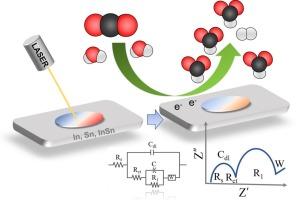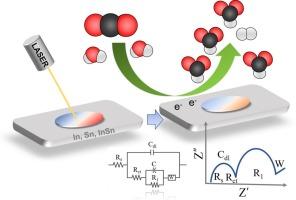激光工程界面调制的In, Sn和InSn电极增强电化学CO2还原
IF 6.9
2区 材料科学
Q2 CHEMISTRY, PHYSICAL
引用次数: 0
摘要
在p嵌段金属如铟(In)、锡(Sn)及其合金(InSn)上电化学CO2还原(EC CO2RR)是一种很有前途的甲酸生产途径。在这里,我们研究了激光诱导的氧化态和表面结构的界面调谐如何调节CO2RR性能。利用1064 nm激光烧蚀,我们控制了金属/金属氧化物界面,并评估了其在不同激光强度下对活性、选择性和反应动力学的影响。适度的激光处理通过增加电化学表面积、抑制析氢和优化电荷转移特性,使甲酸法拉第效率提高到87.5 %。电化学阻抗谱显示,激光处理电极的电荷转移电阻更低,双层电容更高,特别是在co2饱和条件下。在Ar条件下,出现了诱导环,表明氢吸附动力学缓慢,在CO2条件下由于竞争*OCHO结合而被抑制。XPS深度谱分析表明,在CO2RR过程中,表面氧化态发生了动态调节,其中InSn表现出最稳定和选择性的界面。该研究强调了界面氧化物-金属化学和表面重组在决定CO2RR途径和动力学中的关键作用,为高效甲酸选择性电催化剂的设计提供了策略。本文章由计算机程序翻译,如有差异,请以英文原文为准。


Laser-engineered interfacial modulation of In, Sn, and InSn electrodes for enhanced electrochemical CO2 reduction
Electrochemical CO2 reduction (EC CO2RR) on p-block metals such as indium (In), tin (Sn), and their alloy (InSn) is a promising route for formate production. Here, we investigate how laser-induced interfacial tuning of oxidation states and surface structures modulates CO2RR performance. Using 1064 nm laser ablation, we controlled the metal/metal oxide interface and evaluated its impact on activity, selectivity, and reaction kinetics across different laser intensities. Moderate laser treatment enhanced formate Faradaic efficiency up to 87.5 % by increasing electrochemical surface area, suppressing hydrogen evolution, and optimizing charge transfer properties. Electrochemical impedance spectroscopy revealed lower charge transfer resistance and higher double-layer capacitance for laser-treated electrodes, particularly under CO2-saturated conditions. Under Ar condition, inductive loops emerged, indicating sluggish hydrogen adsorption dynamics, which were suppressed under CO2 due to competitive *OCHO binding. XPS depth profiling showed dynamic modulation of surface oxidation states during CO2RR, with InSn exhibiting the most stable and selective interface. This study highlights the crucial role of interfacial oxide–metal chemistry and surface restructuring in dictating CO2RR pathways and kinetics, providing a design strategy for efficient formate-selective electrocatalysts.
求助全文
通过发布文献求助,成功后即可免费获取论文全文。
去求助
来源期刊

Applied Surface Science
工程技术-材料科学:膜
CiteScore
12.50
自引率
7.50%
发文量
3393
审稿时长
67 days
期刊介绍:
Applied Surface Science covers topics contributing to a better understanding of surfaces, interfaces, nanostructures and their applications. The journal is concerned with scientific research on the atomic and molecular level of material properties determined with specific surface analytical techniques and/or computational methods, as well as the processing of such structures.
 求助内容:
求助内容: 应助结果提醒方式:
应助结果提醒方式:


